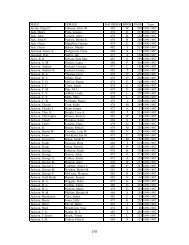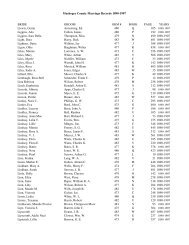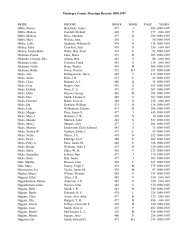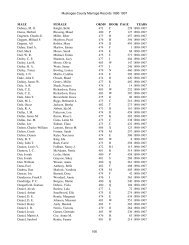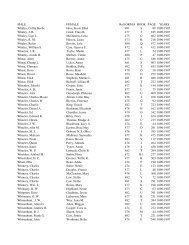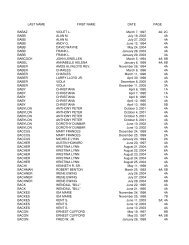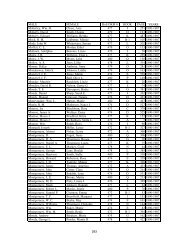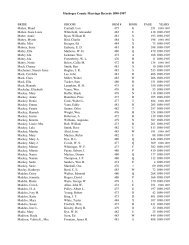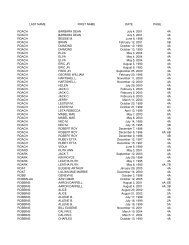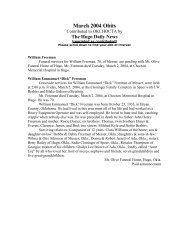Artuami McIntosh Armstrong - OKGenWeb
Artuami McIntosh Armstrong - OKGenWeb
Artuami McIntosh Armstrong - OKGenWeb
You also want an ePaper? Increase the reach of your titles
YUMPU automatically turns print PDFs into web optimized ePapers that Google loves.
Tuskegee #2 in 1887, and voted at Tuskegee in 1894. In 1895, he ran for the<br />
office of Second Chief. The son of <strong>Artuami</strong> Ccache <strong>Armstrong</strong>, and Katie of<br />
Tuskegee, he was a resident of Sapulpa in 1900. The 1882 census shows that<br />
his household included Mekka Yaholo, born in 1837. He was married to Ellen<br />
Perryman (born 1853), daughter of J.M. Perryman, and was the father of John<br />
(1879) and Thomas (1881). Sapaeja had Dawes cc# 835, 2010 and 2295-96.<br />
John's mother was listed as Lucinda of Arbecca Deep Fork.<br />
Sapaeja also lived at Arbecca and was married to Bessie Vann from Cheyahar.<br />
He was the father of Mildred (born 1870), who married Daniel C. Childers and<br />
lived at Broken Arrow in 1900.<br />
Tadake [<strong>Armstrong</strong>] <strong>McIntosh</strong>, I have no information at this time.<br />
A brief family history:<br />
<strong>Artuami</strong> and Katie were in the removal west with their children in the 1842 to<br />
1848 era, based on the fact they could not have migrated west until after the<br />
last child was born in 1842, and it was during this migration that <strong>Artuami</strong> and<br />
Kate died. The Creeks were still migrating in the mid and late 1840's<br />
according to the text, "Among a small number of Creeks yet remaining in<br />
Alabama was a son of Jim Boy named Ward Co-cha-my who did not remove<br />
west until about 1845. Three years later, he returned to Alabama to aid some<br />
of his people in migrating to the Indian Territory. He arrived at Fort Smith<br />
June 24, 1848 with a party of sixty five Indians, but despite his earnest efforts<br />
he was unable to secure a number who were less than 100 Creeks, and most of<br />
them in a deplorable condition; a man by the name of etc.” 4 Also the<br />
testimony of Henry C. Fisher concerning the migration of his father “HENRY<br />
C. FISHER: One of the oldest citizens of Checotah, was born at Fishertown, a<br />
town ten miles southeast of Checotah, and is a son of William Fisher, in<br />
whose honor Fishertown was named. William Fisher was born in Alabama, in<br />
1833, and came to the Territory in 1847, among the last of the Creek Indians<br />
to leave Alabama.” 5<br />
4<br />
“Indian Removal” by Grant Foreman, p. 190. University of Oklahoma Press, Norman,<br />
Oklahoma.<br />
5<br />
“A History of the State of Oklahoma,” Vol. II, p. 174-175. By Luther B. Hill, A.B., Lewis<br />
Publishing Co. Chicago, New York, 1910.<br />
2



